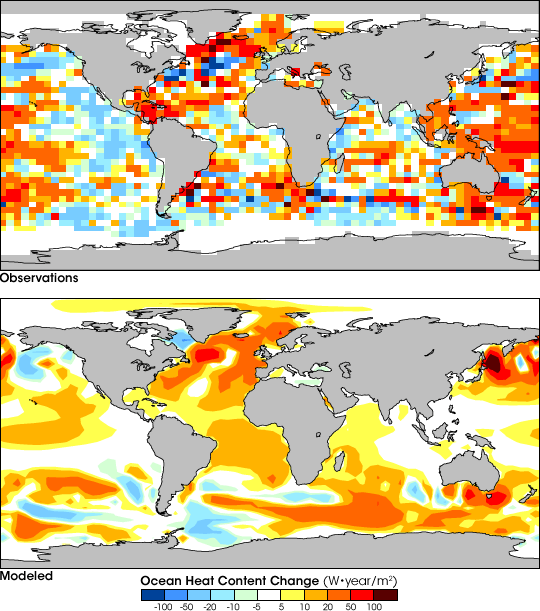

Bad News, Good News | |||
If Earth’s oceans are soaking up the excess heat energy caused by greenhouse gases, then exactly what is the problem? The problem—and perhaps part of the solution as well—is thermal inertia. Inertia is the tendency of an object to resist a change in its current state. The huge heat capacity of the oceans creates thermal inertia in the climate system. Just as a speeding car can take some time to stop after the driver hits the brakes, the Earth’s climate system may take awhile to reflect the change in its energy balance. In other words, there’s a time lag between when the Earth begins to experience an energy imbalance and when the climate fully responds to it. Willis explains, “If we stopped burning all fossil fuels today, the Earth would still warm up a little bit. It would continue absorbing excess energy until it reached [a new] equilibrium point. But if we keep doing what we’re doing, the equilibrium point is going to move further away.” Hansen remarks, “We’re putting in the pipeline additional change that will occur over the next several decades, and which will be difficult if not impossible to avoid.” By his estimates, the current energy imbalance is likely to produce an additional 0.5 to 0.6 degrees Celsius of warming in global average surface temperature on top of the 0.7 degrees that occurred between 1880 and 2000. |
|||
 | |||
Yet the same inertia that could worsen future climate change also gives us time to mitigate the unwanted effects. Many people associate mitigation of global warming with reducing carbon dioxide emissions, but Hansen suggests that this isn’t the only—or even the best—approach. “We’ve reached a point where large climate changes are likely—almost inevitable—this century, and if you want to minimize those, you have to slow the emissions of carbon dioxide. But it will take at least several decades to stabilize carbon dioxide, so, to avoid large climate change, we must reduce other positive [warming] climate forcings, such as soot and methane,” he explains. Dealing with them will also benefit human health. Soot, for instance, can be reduced through more efficient use of diesel fuel and coal, and reducing it would improve air quality. Methane emissions can be reduced by capturing methane at coal mines, landfills, and waste management facilities. Because bacterial activity in flooded soil releases methane, changing fertilizers and irrigation techniques to reduce standing water could reduce methane and lower the risk of mosquito-borne diseases at the same time. |
These maps show observed (top) and modeled (bottom) energy imbalances in the top 750 meters (2,461 feet) of the ocean between 1993 and 2003. See Earth’s Energy out of Balance for more information. (NASA image courtesy James Hansen et al., Goddard Institute for Space Studies.) | ||